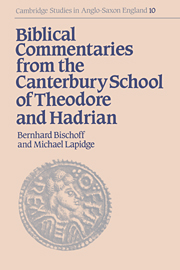Book contents
- Frontmatter
- Contents
- Preface
- List of abbreviations
- 1 Introduction
- 2 Archbishop Theodore
- 3 Abbot Hadrian
- 4 Theodore and Hadrian in England
- 5 The sources of the Canterbury biblical commentaries
- 6 The nature of the Canterbury biblical commentaries
- 7 The manuscripts
- Texts and translations
- Commentary to the texts
- Appendix I Additional manuscript witnesses to the Milan biblical commentaries
- Appendix II Two metrological treatises from the school of Canterbury
- Fig. 1 Cilicia and Syria
- Fig. 2 Constantinople in the seventh century
- Fig. 3 Churches and monasteries of seventh-century Rome
- Fig. 4 Cyrenaica and the Pentapolis
- Fig. 5 Campania and the Bay of Naples
- Fig. 6 Palestine
- Bibliography
- Index of Old English words quoted in the texts
- Index of Greek words quoted in the texts
- Index of names cited in the texts
- General index
6 - The nature of the Canterbury biblical commentaries
Published online by Cambridge University Press: 08 January 2010
- Frontmatter
- Contents
- Preface
- List of abbreviations
- 1 Introduction
- 2 Archbishop Theodore
- 3 Abbot Hadrian
- 4 Theodore and Hadrian in England
- 5 The sources of the Canterbury biblical commentaries
- 6 The nature of the Canterbury biblical commentaries
- 7 The manuscripts
- Texts and translations
- Commentary to the texts
- Appendix I Additional manuscript witnesses to the Milan biblical commentaries
- Appendix II Two metrological treatises from the school of Canterbury
- Fig. 1 Cilicia and Syria
- Fig. 2 Constantinople in the seventh century
- Fig. 3 Churches and monasteries of seventh-century Rome
- Fig. 4 Cyrenaica and the Pentapolis
- Fig. 5 Campania and the Bay of Naples
- Fig. 6 Palestine
- Bibliography
- Index of Old English words quoted in the texts
- Index of Greek words quoted in the texts
- Index of names cited in the texts
- General index
Summary
Thus far we have been concerned with the Mediterranean backgrounds of Theodore and Hadrian, and with the range of learning witnessed in compositions attributable to their Canterbury school, as well as in the biblical commentaries which they produced. It is now time to look more closely at the commentaries themselves: to consider the overall exegetical orientation and individual scholarly concerns which they exhibit, the way in which they were compiled and the extent to which they reflect the procedures of the Canterbury school under the direction of the two great Mediterranean masters.
ANTIOCHENE EXEGESIS
As we have seen, the school of biblical exegesis characterized as ‘Antiochene’ originated at the asketerion or school of Diodore (later bishop of Tarsus) in Antioch in the 370s and 380s. Its principal proponents were Diodore himself, his students Theodore of Mopsuestia and John Chrysostom, and their subsequent adherents, Theodoret of Cyrrhus and Severian of Gabala. Diodore and his followers defined their exegetical approach in distinction to the earlier Alexandrine school of exegesis, characterized by Clement of Alexandria (c. 150 – c. 215) and especially Origen (c. 185–253). The Alexandrines were much influenced by the approach of Philo Judaeus of Alexandria (fl. c. AD 40), who applied the allegorical techniques of Hellenistic philosophy (as practised, for example, by Stoics such as Cornutus in his cosmological interpretation of Homer) to the interpretation of the Old Testament, the underlying assumption being that the divine message of the Old Testament was more sublime than its literal meaning, and that the sublimity could only be glimpsed through allegory.
- Type
- Chapter
- Information
- Publisher: Cambridge University PressPrint publication year: 1995



